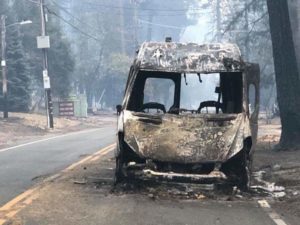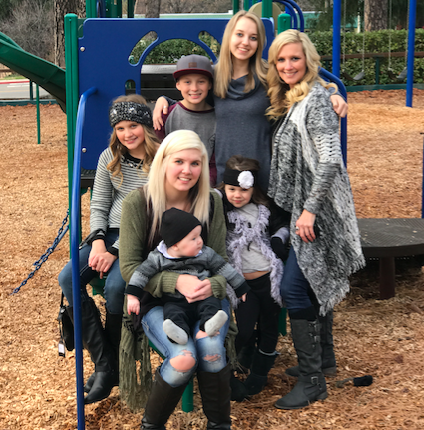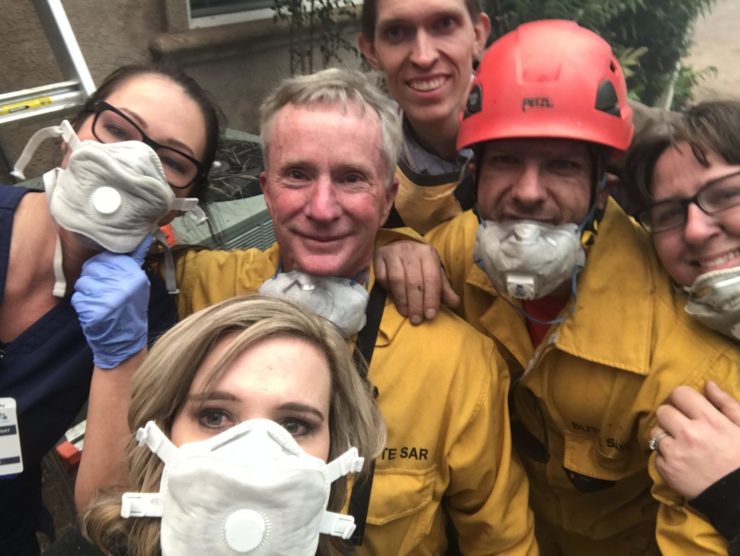The first sentence is treacherous: This is how I die.
It stands alone, in italics – first person, no quote marks. It reads like an epitaph beneath a photograph of six people huddled close – some wearing breathing masks, one a hardhat – so what stands out are the eyes and, where visible, smiles. Smiles – even though they are posing for what could be their last photo.
At the outset of this pell-mell narrative, we don’t know who is living it. We don’t know the name of the “she” who turns to face her death. We only know she is standing “…in the drive way of a sand colored house ... and the air is choked with smoke.” We know that “the sky is nuclear orange” and the “wind is hurling embers against her body and into her blond wavy hair.” And if that’s not enough to secure your full attention, we are told this: “She has just seen an ambulance melt.”

That’s how Los Angeles Times reporter Corina Knoll takes readers to the heart of the notorious Camp fire that overwhelmed Paradise, California, in November, destroying more than 18,000 buildings and leaving 86 dead before it burned itself out. There is nothing traditional about how she tells the story. No official sources. No direct quotes. No context beyond the moment she puts us in. Not even the hint of a nut graf. It was written, as Knoll later told us, on tight deadline, in a rush of emotion and images.
But those images – that intensity and intimacy – were enough to land it on Page 1 on Nov. 22, 2018, amid a torrent of coverage of the deadliest wildfire in California history.
Knoll tells the story of Tamara Ferguson, “a 42-year-old woman who does not surrender." The headline read: As deadly flames approached, a mother called her daughters to say goodbye. But the story became known, simply, as “the final call,” built as it was around what Ferguson believed were her last-ever phone calls to her children.
With a just three lightning-strike sentences high in the story, Knoll illuminates Ferguson’s character:
She graduated high school with a 4-month old and a 4.0 grade point average. She put herself through nursing school while pregnant and with four children. She coaches panicked women through difficult labors.
“These were words a mother of five should never have to say,” Knoll tweeted after this story began flickering across the internet, uniting thousands of people in shared emotion. Presidential advisor KellyAnne Conway tweeted it. So did CNN’s Jake Tapper. So did filmmaker Ava DuVernay. The story hit my inbox on Thanksgiving, the day it ran, accompanied by “OMG!” I could not stop thinking about it – through small talk, through dinner, through dessert. It burned in the back of my mind and clung to my thoughts, like smoke on clothes.
As the story unfolds we learn that Tamara Ferguson is front-and-center among those in that haunting photo – a selfie that she took. She was one of two nurses who, with a pediatrician, two EMTs, two paramedics and two volunteer firefighters, were trapped inside a ring of fire that had erupted Nov. 9 and cremated everything that got in its way.
But while much of the wildfire coverage delivered necessary news about fire paths, visible damage, rising fatality counts and desperate rescue efforts, this story tunnels into a personal reckoning. We are inside Ferguson's thoughts as she confronts mortality, staring down the very moment she knows how and (roughly) when she will die. Knoll captures most of the experience by writing in close third person:
...(she) wonders whether she should stay still when the flames come or get inside the ambulance, which has oxygen tanks and could explode.
Again, nothing is in direct quotes. When Knoll wants Ferguson’s thoughts to be stated directly, she shifts to first person and italics:
What is the best way to be taken by fire?
For the remainder of this lean story, the reader is taken along on a wild ride as Ferguson and her colleagues make what they think is a futile dash to safety, and as Ferguson finally pulls out her pink cell phone and phones her eldest daughter to start her goodbyes.
I spoke with Storyboard’s editor Jacqui Banaszynski about the challenges and risks of writing from inside a story subject’s head. We talked a bit about the work of Gary Smith for Sports Illustrated, Tom Junod for Esquire, Tom Hallman Jr. of The Oregonian and a select few others. That level of intimacy – in reporting and writing – usually takes time for reporter and subject to develop trust, and careful consideration of story structure – even design and type – to convey credibility and transparency.

Knoll dared all that in a few pressured, helter-skelter hours, as she filed feeds for other stories. She took the approach not as some trick of narrative but because, as she said, that's "how I felt it should be told.”
Knoll, who writes for the Times’ metro section, was on the team that won the 2016 Pulitzer for breaking news for coverage of the San Bernardino shootings and subsequent terror investigation. She also contributed to work that won the 2011 Pulitzer Prize in public service for exposing corruption in Bell, California.
In an email conversation with Storyboard, Knoll discussed the pressures and advantages of working on deadline, gives credit to an encouraging colleague and acknowledges leaning on instinct to produce this haunting narrative. Our Q&A has been edited lightly for brevity and clarity.

Where you got your instinct and skill – what seems an uncanny ability to get inside this woman’s head on the day she believes is her last and how, as the flames push closer, her great loves and painful regrets are magnified and dealt with in brief phone calls?
I wish I could sound really deep and tell you how I mapped out this story, but it was written mostly under a very tight daily deadline, and I just did it how I felt it should be told.
I do tend to be driven by a subject's emotion, so it felt pretty natural to write it that way. I didn't use quotes because it felt stronger without them. I think the reporting drives the writing so it helped to have a lot of details to work with.
When did you have the idea for writing about the Camp fire through Tamara Ferguson? And how did your editors get involved or react?
The night before I left for Paradise, I read a bunch of the news coverage. I had heard about a woman who gave birth right before evacuating. I looked for stories about her and there were several that talked about how she survived with a group of first-responders and medical staff, including Tamara Ferguson. There was a mention of last phone calls, and that just seemed like the most heartbreaking thing to ever have to do. I didn't have a clear plan, but I knew I wanted to ask specifically about that. I didn't know what to expect traveling up there so it felt good to have somewhere to begin. I thought maybe I would do a larger story about what people said in final phone calls.
How were you able to meet Tamara, and establish trust and rapport, and then portray her innermost issues – the wonders and baggage of a lifetime – as it's both compressed and amplified by a life-or-death afternoon?
I reached out to Tamara on Facebook the night before I left for Paradise. By then she had actually been interviewed a lot, I think, but she was gracious enough to respond and we set up a time to meet the next day. I told her I wanted to zero in on her phone call, what she said and why. Tamara was forthright with details and emotions and willing to answer all types of questions, which really helped. Still, it was my first day in Paradise and I wasn't sure if I had a story or what kind of story, so after that I did interviews for other possible articles.
There was a mention of last phone calls, and that just seemed like the most heartbreaking thing to ever have to do.
Two days later, my colleague Ron Lin came to the area to report. We met up and talked through story ideas. I mentioned the idea I had about the last phone call one makes and telling it through Tamara, and he immediately encouraged me to write it. I was supposed to send in feeds for a different story, but Ron inspired me so much that I ran to a coffee shop and quickly wrote up the first few paragraphs and sent it to two editors to give them a sense of what I was thinking. Then I went out and got feeds for the other story.
The following morning, I was told they wanted Tamara's story for A1, which meant a 3 p.m. deadline. So from then on it became a daily. The interview with Tamara was the only one that I recorded, because we talked for about one-and-a-half hours and there were so many details. I hadn't yet finished transcribing the entire tape, so I was frantically doing that while writing. I also had to call and text Tamara several times throughout with follow-up questions.
In some ways the pressure of a deadline helped.
I turned it in, a few words were tweaked, and that was it. In some ways the pressure of a deadline helped. If I had been told to hand it in later, I might have approached it differently or maybe an editor would have suggested reshaping it. Who knows? I definitely wish there had been more time to polish it though.
How many different interviews were conducted and then distilled to tell Tamara’s story?
I did two separate interviews, one with Tamara and one with her daughter, Savannah. I wasn't on deadline at the time of the interviews – I didn't even know if it would become a story.
Was your interviewing technique different than it would have been for more ordinary reporting? Can you share some of the questions you asked?
I don't know that it was any different than reporting for a feature. I repeatedly asked her about what she said in the phone call and why. I realized that we probably all would say similar things in that situation, but the why is what differentiates us. And I asked a lot of specific questions about the scene, because in order to understand why someone makes that kind of phone call, you have to know exactly what they were facing.
Did you tell Tamara how you wanted to take readers along inside her head/heart/journey?
I told her initially that I wanted to hear her story even though I wasn't sure what would come of it. When I was actually writing it on deadline, I explained to her my approach so she wouldn't be caught by surprise.
Iknow you’ve had a tremendous response from readers, but what specifically are they responding to?
The response was unexpected and a tad overwhelming, but in a good way. I appreciated anybody who took the time to say something about it. And so grateful that Tamara was open to me writing about her in such a personal way.
I think maybe the pacing and length of the story was helpful – we all want to do those long narratives, but sometimes a quick read is more digestible. It probably helped that it ran on Thanksgiving when people are feeling particularly emotional and generous.
EDITOR'S NOTE: A special thanks to Tamara Ferguson. Despite everything she's dealing with, she was fast and gracious in responding to our request to use her photos for this post. We send all wishes for hope and home to her and everyone displaced by the California fires, or by disasters – natural and manmade – anywhere.



